
History and Medals of the RAF.

In the office
"In the office, that is a term that fighter pilots know and use well, the office being where they spend their time and do their work. Unlike an office in civilian street, this is one office you don't step into unless you have the right stuff".
An old fighter pilot saying.
"
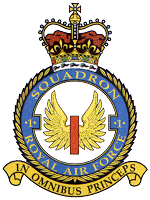
| Fighter Command was formed on
14th July 1936 when Air Marshal Sir Hugh C.T. Dowding
arrived at Bently Priory near Stanmore inmiddlesex to
form Headquarters, Fighter Command. Immediately available
were nine fighter stations holding seventeen fighter
squadrons, of which three were in the Middle East, and
five Army-co-operation squadrons of which he had only
administrative control. These forces would be able to cover London and radiate outwards as far northwards as York and westwards as the Solent. As the German bombers would be stretched when flying from German bases to fly outside of these areas, Accordingly he concentrated his forces in the south and east of England and divided into two groups, No.11 Group which covered the area south of a line lying east and west through Bedford and No.12 Group which had as its area the Midlands and east Anglia between this line and York. The Command's entire fighter force consisted of biplane armed with two machine guns at this time, the monoplane fighters were only in prototype form. To control this force the command set up a Command Operations Room and in addition each group had its own operations room; and soon it was found advantageous to delegate as much of the operations as possible to group level. A key man in evolving an effective operation system was Air Vice-Marshal Keith Park, who was himself to play a vital role as No.11 Group Commander during the Battle of Britain. Information for the operations rooms came from two sources, the new radar stations and the Observer Corps, the latter tracing aircraft passage over land and the radar stations tracking incoming aircraft before they reached shore. In 1937, Fighter Command staged its first air exercises which led to the conclusion that if British light bombers could outrun Fighter Command's biplane fighters then the whole command would be unable to defend British airspace until the new monoplane fighters came into service in huge numbers. The whole command bent itself to the task and to the construction of more airfields, installations and quarters. At the same time, the Commander-in-Chief begun a policy of operational integration with Army Anti-Aircraft Command which lasted throughout the war and prevented what could have been a source of major friction. By the time of the Munich Crisis, Fighter Command was heading towards operational efficiency but was still unable to defend British Skies, The respite gained the Command valuable time to complete its preparations. In 1939, as war loomed, Fighter Command was pressed sorely to release squadrons for service in support of the Allied armies if military actions were taken. In the end only four fighter squadrons were sent and two Auxiliary squadrons followed a month later. In the event, Dowding was given another six-seven months to bring Fighter Command upto a level where it could defend Britain. But at the same time, Fighter Command was ordered to defend Scapa Flow in the Orkneys, drawing on three squadrons to do so and Convoy protection, and with the expanse of the command, it expanded westwards forming No. 10 Group to cover the west country. In the Norway debacle Fighter Command lost only two squadrons (one of Gladiators and one of Hurricanes). The Western front was also closed by the Dunkirk Evacuation at this time, with a large portion of No.11 Group providing air cover. The build up to the Battle of Britain involved sporadic raids on Channel shipping by the Germans to weaken Fighter Command. Fighter Command was then involved in The Battle of Britain, which closed on the 15th September with No.11 Group repelling the all out Luftwaffe attack on London that Sunday. Hitler now postponed his invasion of Britain and turned his attention to Russia. The Command now turned its attention towards developing AI, Airborne Interception radar to make the Luftwaffe's night-raids on London too costly. At the same time Air Chief Marshal Dowding and No.11 Group commander Park left the command. Throughout 1941 Fighter Command saw a the AI develop to the point where it was making considerable holes in the German night raids and even attacking them over France as they took off or landed, mostly the AI was deployed in Bristol Blenheim or Douglas Boston night fighters. By this time the air defence of Britain had extended north and covered north of York and west of the Solent with No. 13 Group. The drop in the hectic fighting in the south allowed the command to also form No.14 group to cover Scotland, the Orkneys and Shetlands, with No.9 group covering the North West Midlands. Sir William Sholto Douglas, Dowding's replacement at Bentley Priory now brought into play another tactic, one spearheaded by Leigh-Mallory with his 'Big-wing' philosophies. On the 10th January 1941, the first Circus operation was flown. these were a light bomber squadron under strong fighter escort which made short daylight forays against coastal targets in occupied europe. This first such operation, involving a Blenheim IV attack on gun emplacements in the Pas de Calais covered by Hurricane and Spitfire escorts put Fighter Command on the offensive after over a year and a half of war. As the year wore on, the attacks became more sophisticated with assaults in different directions, decoys etc. It achieved the aim of wearing down the Luftwaffe a large portion of which had already been transferred to the Russian front. The other offensive innovation instituted under Douglas at Bentley Priory was the Rhubarb operations; Single or paired fighters would raid enemy targets with machine-gun and cannon fire under low cloud cover, at the same time as it was damaging the enemy, these missions were also preparing the Command for the day when it would go free-ranging over the Continent in the inevitable return to Europe. At the same time Fighter Command deployed 151 Wing to Russia, consisting of two Hurricane squadrons to prepare the Russians to fly the aircraft themselves when provided by the Allies. As Summer turned to Autumn, Fighter Command was visited by another problem, this one in the form of the Focke-Wulf FW 190, a fighter which could outperform anything in the Commands' inventory including the Spitfire Vb. However, the Typhoon the Commands' antidote to the FW 190 was having troubles with its engine, as it turned out the Typhoons' troubles with high-altiude performance led it in a different direction, as it eventually became the pioneer of the Close-Air-Support mission, flying alongside its companion the Westland Whirlwind. And beyond that came the revamped Circus operations, the Ramrods which held the enemy target as their priority instead of the Luftwaffe. In February 1942, the German battlecruisers Scharnhorst and Gneisenau dashed through the Channel without being stopped, a serious shock to Fighter Command. As 1942 wore on the FW 1940 became more numerous and Rolls-Royces new 1600hp engines came into being with the Spitfire IX. By the summer, Fighter Command was putting wings of Mk.IX Spitfires into the sky with the specific task of destroying any FW 190s, The 190 was also used by the Germans in Rhubarb style raids on British coastal towns through late 1942 and early 1943. But at low level, the typhoon could master the 190 and outmaneuver it at high speed. The Mosquito made its debut in early 1943 with the Night fighters taking over from the Beaufighter. 1942 also saw a steup in nuisance raids on Britain by the Luftwaffe and systematic bombing of British cities in return for the increasingly violent demolition of German cities and industry by the ever-more effective Bomber Command. With the end of the year the AI Mk VIII had made its debut and eliminated the problem of low-level clutter which some Germans raiders were able to use on moon-lit nights to avoid the nightfighters. The Command also covered the catastrophic Dieppe landings during 1942 in a mammoth dogfight as the Luftwaffe through itself against the landings' protective cover of Fighter Command aircraft. This also led to the discovery that the Rhubarb operations against the Germans' fortified gun emplacements were not as successful as first thought. Leading to changes which would be welcome during the launch of the second front the following year. As the year closed, Douglas was succeeded by Sir Trafford Leigh-Mallory. 1943 saw the USAAF join in the effort to pound the reich into oblivion in force and the commands Ramrod commitments increased enormously. Another spate of retaliatory attacks on British cities by the Luftwaffe ensured that the Command did not lose touch with its defensive skills. As the plans for the European offensive took shape, the Command formed, along with the USAAF 8th Air Force, the 2nd Tactical Air Force to cover operations on mainland Europe borne out of the lessons of North Africa's 1st Tactical Air Force. The 2nd TAF cost the Command a third of its strength and it reverted back to its old-title of Air Defence of Great Britain. Leigh-Mallory left to command the 2s TAF and Air Marshal Roderic Hill took over the Command. Hill's first challenge was to neutralize the next series of Luftwaffe reprisal raids on London, the "little Blitz" of 1944 of no effect. The badly mauled Luftwaffe, its morale at an all-time low following its defeats in Russia and Italy, was unable to copy Bomber Commands Pathfinder techniques with any success and was flying the raids under the almost constant presence of British night-fighters which tore great holes in their numbers. After each raid, the Germans bomber force needed several days to recover enough from the onslaught of the night-fighter Mosquitos before it could stage another such raid. By April, it had thrown i the towel and left reprisals to the Germans vengeance or V weapons. The V weapons were now Fighter Command, temporarily known as ADGB, main problem. Despite heavy bombing raids, some sites remained operational and having just completed the massive task of covering the D-Day landings successfully, it turned its attention to the increasing attacks by V weapons on London and the south-east. Hill assigned fourteen squadrons to deal with the V-1 flying bomb threat immediately. all of these squadrons were equipped with the fastest aircraft in the command the Spitfire XIVs, Tempests and at one point, the first squadron of Meteors. Pilots soon found the best-and safest way-to destroy these 'flying bombs' was to fly along side and nudge the robot aircraft with the wingtip of their aircraft, thus tilting it and sending the gyroscope controlled aircraft into the ground or sea. The V-1 threat passed once allied forces overrun their launching sites in September, and the only attacks were by German bombers launching the weapons from sea, which was easily countered by shooting down the parent aircraft before it could launch the weapon. The next problem came in the form of the V2, again, Hill deployed the superb Spitfire XVIs in their ground attack role to obliterate any launching sites, all of which were in the hook of Holland area. A V-2 was impossible to stop once airborne. Although their effect on the war, like the V-1 was minimal they continued to be fired until March 1945. In October 1944, Fighter Command was once again relabelled Fighter Command and relaxed, its gaze watchful but ready to pounce in an instant if needed. the end of the war in Europe saw a winding down of the force under Sir James Robb as it reformed into a peacetime air defence force. |
Medals of the RAF.
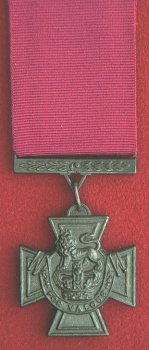 |
The Victoria Cross was
established in 1856, during the Crimean War. The VC is
the most highly coveted and highly valued decoration
which a British serviceman might be awarded for a
performing a single act of valor and devotion to their
country in the presence of an enemy. Bars were awarded
for subsequent acts of valor. Until 1942, VC medallions
were made from the bronze of cannons captured in the
Crimean War. The escalation of the First World War after the deadlock of 1914 led the British military to recognize the need for a more definitive hierarchy of awards for gallantry in action. |
 |
The Military Cross (MC) and the... |
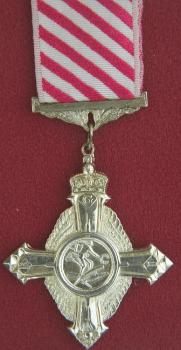 |
Air Force Cross (AFC) and... |
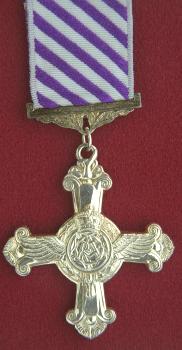 |
The Distinguished Flying Cross (DFC) and... |
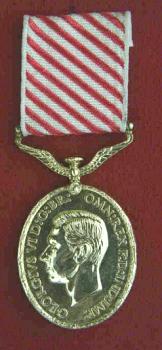 |
Air Force Medal (AFM) were instituted as the non-combat versions of the above awards, and as such they were awarded in much smaller numbers than their combat counterparts. In the period 1918-1919, there were 1079 DFCs awarded, and only 679 AFCs. DFM and AFM, for enlisted men and NCOs, were even rarer. Only 104 of the former and 102 of the latter were awarded for the same period. |
 |
Distinguished Flying Medal (DFM), like the MC and MM, were awarded to officers and enlisted men respectively. These were the first awards of the new Royal Air Force, which was formed from the Royal Flying Corps as a separate entity in 1918. These awards were made for "valour, courage or devotion to duty performed whilst flying in active operations against the enemy." They could not be awarded for non-combat achievements or heroism. |
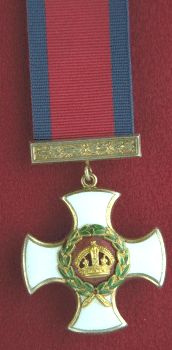 |
The Distinguished Service Order (DSO) dates back to 1886, during the reign of Queen Victoria. The award is generally not given to officers below the rank of Captain. In terms of gallantry awards, The DSO ranks below the Victoria Cross and above the Military Cross, in order of precedence. It is almost always awarded for gallantry in action. There were 8,981 awards for the First World War. |